Profile

|
Dr. Tim Weissker |
Tim Weißker joined the Virtual Reality Team as a postdoctoral researcher in 2022. Before, he worked as a research assistant with the Virtual Reality and Visualization Research Group at Bauhaus-Universität Weimar, where he also completed his doctoral research on "Group Navigation in Multi-User Virtual Reality" in 2021. His research interests include the design of 3D interaction techniques, the study of collaborative work among collocated and remote user groups, and the evaluation of user performance and comfort in virtual environments.

|
|
 orcid.org/0000-0001-9119-811X orcid.org/0000-0001-9119-811X
|
| https://www.tim-weissker.de |
- Doctor rerum naturalium, Virtual Reality and Visualization Research Group, Bauhaus-Universität Weimar, December 2021
- Master of Science, Computer Science and Media, Bauhaus-Universität Weimar, May 2017
- Bachelor of Science, Medieninformatik, Bauhaus-Universität Weimar, October 2014
Publications
Front Matter: The Third Workshop on Locomotion and Wayfinding in XR (LocXR)

The Third Workshop on Locomotion and Wayfinding in XR, held in conjunction with IEEE VR 2025 in Saint-Malo, France, is dedicated to advancing research and fostering discussions around the critical topics of navigation in extended reality (XR). Navigation is a fundamental form of user interaction in XR, yet it poses numerous challenges in conceptual design, technical implementation, and systematic evaluation. By bringing together researchers and practitioners, this workshop aims to address these challenges and push the boundaries of what is achievable in XR navigation.
@inproceedings{Weissker2025,
author={T. {Weissker} and D. {Zielasko}},
booktitle={2025 IEEE Conference on Virtual Reality and 3D User Interfaces Abstracts and Workshops (VRW)},
title={The Third Workshop on Locomotion and Wayfinding in XR (LocXR)},
year={2025},
volume={},
number={},
pages={239-240},
doi={10.1109/VRW66409.2025.00058}
}
PASCAL - A Collaboration Technique Between Non-Collocated Avatars in Large Collaborative Virtual Environments
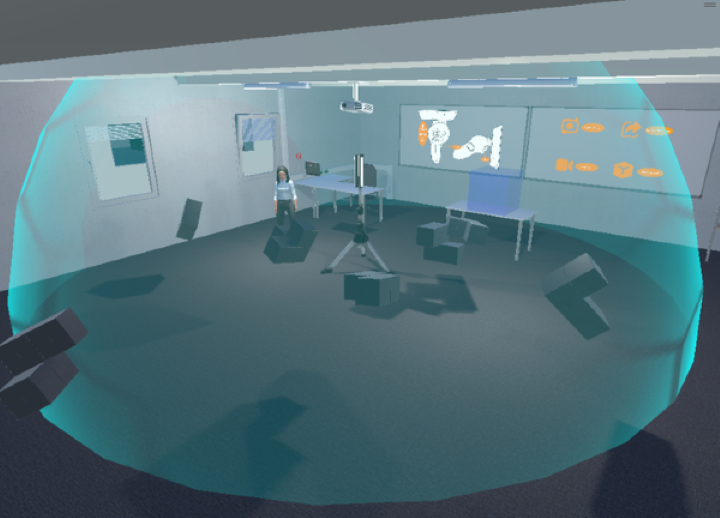
Collaborative work in large virtual environments often requires transitions from loosely-coupled collaboration at different locations to tightly-coupled collaboration at a common meeting point. Inspired by prior work on the continuum between these extremes, we present two novel interaction techniques designed to share spatial context while collaborating over large virtual distances. The first method replicates the familiar setup of a video conference by providing users with a virtual tablet to share video feeds with their peers. The second method called PASCAL (Parallel Avatars in a Shared Collaborative Aura Link) enables users to share their immediate spatial surroundings with others by creating synchronized copies of it at the remote locations of their collaborators. We evaluated both techniques in a within-subject user study, in which 24 participants were tasked with solving a puzzle in groups of two. Our results indicate that the additional contextual information provided by PASCAL had significantly positive effects on task completion time, ease of communication, mutual understanding, and co-presence. As a result, our insights contribute to the repertoire of successful interaction techniques to mediate between loosely- and tightly-coupled work in collaborative virtual environments.
@article{Gilbert2025,
author={D. {Gilbert} and A. {Bose} and T. {Kuhlen} and T. {Weissker}},
journal={IEEE Transactions on Visualization and Computer Graphics},
title={PASCAL - A Collaboration Technique Between Non-Collocated Avatars in Large Collaborative Virtual Environments},
year={2025},
volume={31},
number={5},
pages={1268-1278},
doi={10.1109/TVCG.2025.3549175}
}
Minimalism or Creative Chaos? On the Arrangement and Analysis of Numerous Scatterplots in Immersi-ve 3D Knowledge Spaces
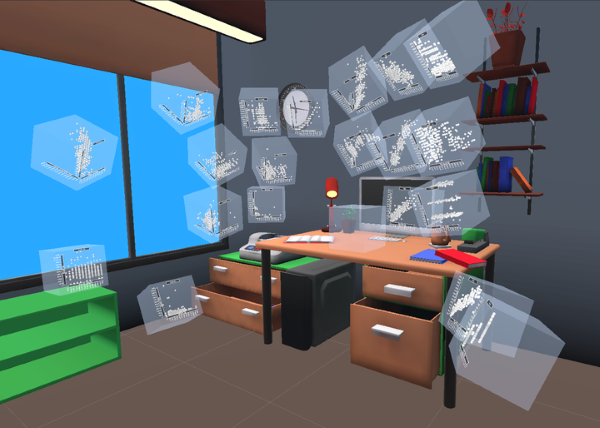
Working with scatterplots is a classic everyday task for data analysts, which gets increasingly complex the more plots are required to form an understanding of the underlying data. To help analysts retrieve relevant plots more quickly when they are needed, immersive virtual environments (iVEs) provide them with the option to freely arrange scatterplots in the 3D space around them. In this paper, we investigate the impact of different virtual environments on the users' ability to quickly find and retrieve individual scatterplots from a larger collection. We tested three different scenarios, all having in common that users were able to position the plots freely in space according to their own needs, but each providing them with varying numbers of landmarks serving as visual cues - an Emptycene as a baseline condition, a single landmark condition with one prominent visual cue being a Desk, and a multiple landmarks condition being a virtual Office. Results from a between-subject investigation with 45 participants indicate that the time and effort users invest in arranging their plots within an iVE had a greater impact on memory performance than the design of the iVE itself. We report on the individual arrangement strategies that participants used to solve the task effectively and underline the importance of an active arrangement phase for supporting the spatial memorization of scatterplots in iVEs.
@article{Derksen2025,
author={M. {Derksen} and T. {Kuhlen} and M. {Botsch} and T. {Weissker}},
journal={IEEE Transactions on Visualization and Computer Graphics},
title={Minimalism or Creative Chaos? On the Arrangement and Analysis of Numerous Scatterplots in Immersive 3D Knowledge Spaces},
year={2025},
volume={31},
number={5},
pages={746-756},
doi={10.1109/TVCG.2025.3549546}
}
Virtual Reality as a Tool for Monitoring Additive Manufacturing Processes via Digital Shadows
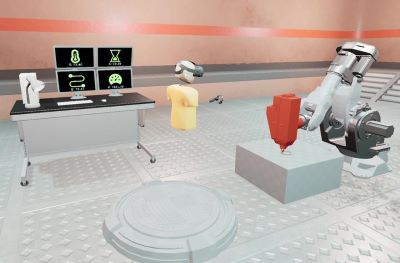
We present a data acquisition and visualization pipeline that allows experts to monitor additive manufacturing processes, in particular laser metal deposition with wire (LMD-w) processes, in immersive virtual reality. Our virtual environment consists of a digital shadow of the LMD-w production site enriched with additional measurement data shown on both static as well as handheld virtual displays. Users can explore the production site by enhanced teleportation capabilities that enable them to change their scale as well as their elevation above the ground plane. In an exploratory user study with 22 participants, we demonstrate that our system is generally suitable for the supervision of LMD-w processes while generating low task load and cybersickness. Therefore, it serves as a first promising step towards the successful application of virtual reality technology in the comparatively young field of additive manufacturing.
Semi-Automated Guided Teleportation through Immersive Virtual Environments
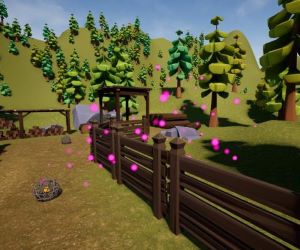
Immersive knowledge spaces like museums or cultural sites are often explored by traversing pre-defined paths that are curated to unfold a specific educational narrative. To support this type of guided exploration in VR, we present a semi-automated, handsfree path traversal technique based on teleportation that features a slow-paced interaction workflow targeted at fostering knowledge acquisition and maintaining spatial awareness. In an empirical user study with 34 participants, we evaluated two variations of our technique, differing in the presence or absence of intermediate teleportation points between the main points of interest along the route. While visiting additional intermediate points was objectively less efficient, our results indicate significant benefits of this approach regarding the user’s spatial awareness and perception of interface dependability. However, the user’s perception of flow, presence, attractiveness, perspicuity, and stimulation did not differ significantly. The overall positive reception of our approach encourages further research into semi-automated locomotion based on teleportation and provides initial insights into the design space of successful techniques in this domain.
IntenSelect+: Enhancing Score-Based Selection in Virtual Reality

Object selection in virtual environments is one of the most common and recurring interaction tasks. Therefore, the used technique can critically influence a system’s overall efficiency and usability. IntenSelect is a scoring-based selection-by-volume technique that was shown to offer improved selection performance over conventional raycasting in virtual reality. This initial method, however, is most pronounced for small spherical objects that converge to a point-like appearance only, is challenging to parameterize, and has inherent limitations in terms of flexibility. We present an enhanced version of IntenSelect called IntenSelect+ designed to overcome multiple shortcomings of the original IntenSelect approach. In an empirical within-subjects user study with 42 participants, we compared IntenSelect+ to IntenSelect and conventional raycasting on various complex object configurations motivated by prior work. In addition to replicating the previously shown benefits of IntenSelect over raycasting, our results demonstrate significant advantages of IntenSelect+ over IntenSelect regarding selection performance, task load, and user experience. We, therefore, conclude that IntenSelect+ is a promising enhancement of the original approach that enables faster, more precise, and more comfortable object selection in immersive virtual environments.
» Show BibTeX
@ARTICLE{10459000,
author={Krüger, Marcel and Gerrits, Tim and Römer, Timon and Kuhlen, Torsten and Weissker, Tim},
journal={IEEE Transactions on Visualization and Computer Graphics},
title={IntenSelect+: Enhancing Score-Based Selection in Virtual Reality},
year={2024},
volume={},
number={},
pages={1-10},
keywords={Visualization;Three-dimensional displays;Task analysis;Usability;Virtual environments;Shape;Engines;Virtual Reality;3D User Interfaces;3D Interaction;Selection;Score-Based Selection;Temporal Selection;IntenSelect},
Demo: Webcam-based Hand- and Object-Tracking for a Desktop Workspace in Virtual Reality

As virtual reality overlays the user’s view, challenges arise when interaction with their physical surroundings is still needed. In a seated workspace environment interaction with the physical surroundings can be essential to enable productive working. Interaction with e.g. physical mouse and keyboard can be difficult when no visual reference is given to where they are placed. This demo shows a combination of computer vision-based marker detection with machine-learning-based hand detection to bring users’ hands and arbitrary objects into VR.
@inproceedings{10.1145/3677386.3688879,
author = {Pape, Sebastian and Beierle, Jonathan Heinrich and Kuhlen, Torsten Wolfgang and Weissker, Tim},
title = {Webcam-based Hand- and Object-Tracking for a Desktop Workspace in Virtual Reality},
year = {2024},
isbn = {9798400710889},
publisher = {Association for Computing Machinery},
address = {New York, NY, USA},
url = {https://doi.org/10.1145/3677386.3688879},
doi = {10.1145/3677386.3688879},
abstract = {As virtual reality overlays the user’s view, challenges arise when interaction with their physical surroundings is still needed. In a seated workspace environment interaction with the physical surroundings can be essential to enable productive working. Interaction with e.g. physical mouse and keyboard can be difficult when no visual reference is given to where they are placed. This demo shows a combination of computer vision-based marker detection with machine-learning-based hand detection to bring users’ hands and arbitrary objects into VR.},
booktitle = {Proceedings of the 2024 ACM Symposium on Spatial User Interaction},
articleno = {64},
numpages = {2},
keywords = {Hand-Tracking, Object-Tracking, Physical Props, Virtual Reality, Webcam},
location = {Trier, Germany},
series = {SUI '24}
Come Look at This: Supporting Fluent Transitions between Tightly and Loosely Coupled Collaboration in Social Virtual Reality
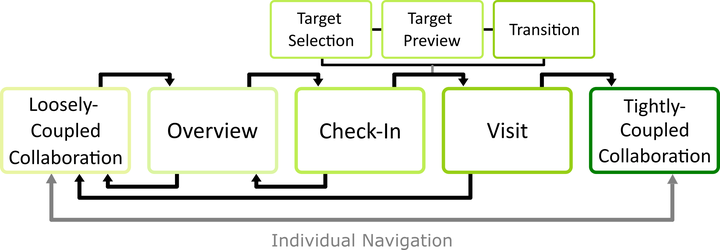
Collaborative work in social virtual reality often requires an interplay of loosely coupled collaboration from different virtual locations and tightly coupled face-to-face collaboration. Without appropriate system mediation, however, transitioning between these phases requires high navigation and coordination efforts. In this paper, we present an interaction system that allows collaborators in virtual reality to seamlessly switch between different collaboration models known from related work. To this end, we present collaborators with functionalities that let them work on individual sub-tasks in different virtual locations, consult each other using asymmetric interaction patterns while keeping their current location, and temporarily or permanently join each other for face-to-face interaction. We evaluated our methods in a user study with 32 participants working in teams of two. Our quantitative results indicate that delegating the target selection process for a long-distance teleport significantly improves placement accuracy and decreases task load within the team. Our qualitative user feedback shows that our system can be applied to support flexible collaboration. In addition, the proposed interaction sequence received positive evaluations from teams with varying VR experiences.
@ARTICLE{10568966,
author={Bimberg, Pauline and Zielasko, Daniel and Weyers, Benjamin and Froehlich, Bernd and Weissker, Tim},
journal={IEEE Transactions on Visualization and Computer Graphics},
title={Come Look at This: Supporting Fluent Transitions between Tightly and Loosely Coupled Collaboration in Social Virtual Reality},
year={2024},
volume={},
number={},
pages={1-17},
keywords={Collaboration;Virtual environments;Navigation;Task analysis;Virtual reality;Three-dimensional displays;Teleportation;Virtual Reality;3D User Interfaces;Multi-User Environments;Social VR;Groupwork;Collaborative Interfaces},
doi={10.1109/TVCG.2024.3418009}}
Poster: Travel Speed, Spatial Awareness, And Implications for Egocentric Target-Selection-Based Teleportation - A Replication Design
Virtual travel in Virtual Reality experiences is common, offering users the ability to explore expansive virtual spaces. Various interfaces exist for virtual travel, with speed playing a crucial role in user experience and spatial awareness. Teleportation-based interfaces provide instantaneous transitions, whereas continuous and semi-continuous methods vary in speed and control. Prior research by Bowman et al. highlighted the impact of travel speed on spatial awareness demonstrating that instantaneous travel can lead to user disorientation. However, additional cues, such as visual target selection, can aid in reorientation. This study replicates and extends Bowman’s experiment, investigating the influence of travel speed and visual target cues on spatial orientation.
On the Computation of User Placements for Virtual Formation Adjustments during Group Navigation
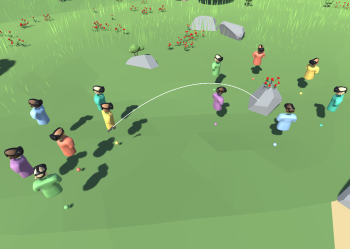
Several group navigation techniques enable a single navigator to control travel for all group members simultaneously in social virtual reality. A key aspect of this process is the ability to rearrange the group into a new formation to facilitate the joint observation of the scene or to avoid obstacles on the way. However, the question of how users should be distributed within the new formation to create an intuitive transition that minimizes disruptions of ongoing social activities is currently not explored. In this paper, we begin to close this gap by introducing four user placement strategies based on mathematical considerations, discussing their benefits and drawbacks, and sketching further novel ideas to approach this topic from different angles in future work. Our work, therefore, contributes to the overarching goal of making group interactions in social virtual reality more intuitive and comfortable for the involved users.
» Show BibTeX
@INPROCEEDINGS{10536250,
author={Weissker, Tim and Franzgrote, Matthis and Kuhlen, Torsten and Gerrits, Tim},
booktitle={2024 IEEE Conference on Virtual Reality and 3D User Interfaces Abstracts and Workshops (VRW)},
title={On the Computation of User Placements for Virtual Formation Adjustments During Group Navigation},
year={2024},
volume={},
number={},
pages={396-402},
keywords={Three-dimensional displays;Navigation;Conferences;Virtual reality;Human factors;User interfaces;Task analysis;Human-centered computing—Human computer interaction (HCI)—Interaction paradigms—Virtual reality;Human-centered computing—Interaction design—Interaction design theory, concepts and paradigms},
doi={10.1109/VRW62533.2024.00077}}
Try This for Size: Multi-Scale Teleportation in Immersive Virtual Reality
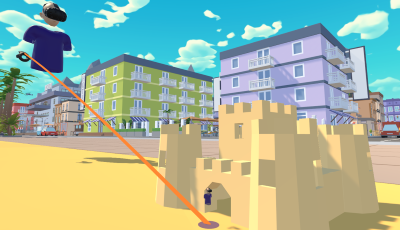
The ability of a user to adjust their own scale while traveling through virtual environments enables them to inspect tiny features being ant-sized and to gain an overview of the surroundings as a giant. While prior work has almost exclusively focused on steering-based interfaces for multi-scale travel, we present three novel teleportation-based techniques that avoid continuous motion flow to reduce the risk of cybersickness. Our approaches build on the extension of known teleportation workflows and suggest specifying scale adjustments either simultaneously with, as a connected second step after, or separately from the user’s new horizontal position. The results of a two-part user study with 30 participants indicate that the simultaneous and connected specification paradigms are both suitable candidates for effective and comfortable multi-scale teleportation with nuanced individual benefits. Scale specification as a separate mode, on the other hand, was considered less beneficial. We compare our findings to prior research and publish the executable of our user study to facilitate replication and further analyses.
» Show BibTeX
@ARTICLE{10458384,
author={Weissker, Tim and Franzgrote, Matthis and Kuhlen, Torsten},
journal={IEEE Transactions on Visualization and Computer Graphics},
title={Try This for Size: Multi-Scale Teleportation in Immersive Virtual Reality},
year={2024},
volume={30},
number={5},
pages={2298-2308},
keywords={Teleportation;Navigation;Virtual environments;Three-dimensional displays;Visualization;Cybersickness;Collaboration;Virtual Reality;3D User Interfaces;3D Navigation;Head-Mounted Display;Teleportation;Multi-Scale},
doi={10.1109/TVCG.2024.3372043}}
TENETvr: Comprehensible Temporal Teleportation in Time-Varying Virtual Environments
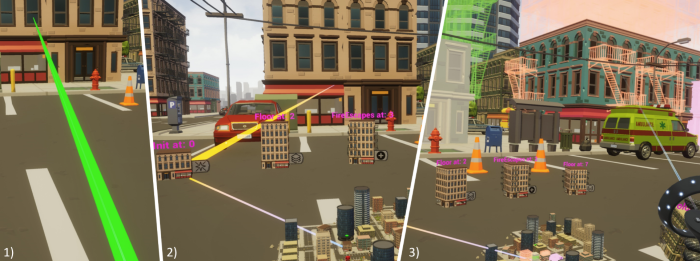
The iterative design process of virtual environments commonly generates a history of revisions that each represent the state of the scene at a different point in time. Browsing through these discrete time points by common temporal navigation interfaces like time sliders, however, can be inaccurate and lead to an uncomfortably high number of visual changes in a short time. In this paper, we therefore present a novel technique called TENETvr (Temporal Exploration and Navigation in virtual Environments via Teleportation) that allows for efficient teleportation-based travel to time points in which a particular object of interest changed. Unlike previous systems, we suggest that changes affecting other objects in the same time span should also be mediated before the teleport to improve predictability. We therefore propose visualizations for nine different types of additions, property changes, and deletions. In a formal user study with 20 participants, we confirmed that this addition leads to significantly more efficient change detection, lower task loads, and higher usability ratings, therefore reducing temporal disorientation.
@INPROCEEDINGS{10316438,
author={Rupp, Daniel and Kuhlen, Torsten and Weissker, Tim},
booktitle={2023 IEEE International Symposium on Mixed and Augmented Reality (ISMAR)},
title={{TENETvr: Comprehensible Temporal Teleportation in Time-Varying Virtual Environments}},
year={2023},
volume={},
number={},
pages={922-929},
doi={10.1109/ISMAR59233.2023.00108}}
Who Did What When? Discovering Complex Historical Interrelations in Immersive Virtual Reality
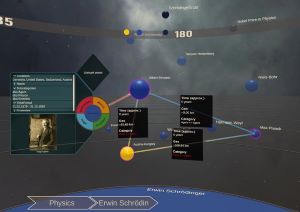
Traditional digital tools for exploring historical data mostly rely on conventional 2D visualizations, which often cannot reveal all relevant interrelationships between historical fragments (e.g., persons or events). In this paper, we present a novel interactive exploration tool for historical data in VR, which represents fragments as spheres in a 3D environment and arranges them around the user based on their temporal, geo, categorical and semantic similarity. Quantitative and qualitative results from a user study with 29 participants revealed that most participants considered the virtual space and the abstract fragment representation well-suited to explore historical data and to discover complex interrelationships. These results were particularly underlined by high usability scores in terms of attractiveness, stimulation, and novelty, while researching historical facts with our system did not impose unexpectedly high task loads. Additionally, the insights from our post-study interviews provided valuable suggestions for future developments to further expand the possibilities of our system.
@INPROCEEDINGS{10316480,
author={Derksen, Melanie and Becker, Julia and Elahi, Mohammad Fazleh and Maier, Angelika and Maile, Marius and Pätzold, Ingo and Penningroth, Jonas and Reglin, Bettina and Rothgänger, Markus and Cimiano, Philipp and Schubert, Erich and Schwandt, Silke and Kuhlen, Torsten and Botsch, Mario and Weissker, Tim},
booktitle={2023 IEEE International Symposium on Mixed and Augmented Reality (ISMAR)},
title={{Who Did What When? Discovering Complex Historical Interrelations in Immersive Virtual Reality}},
year={2023},
volume={},
number={},
pages={129-137},
doi={10.1109/ISMAR59233.2023.00027}}
Stay Vigilant: The Threat of a Replication Crisis in VR Locomotion Research
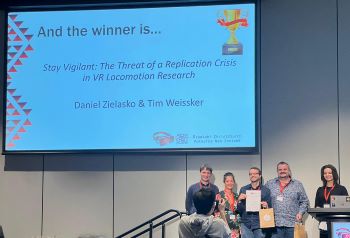
The ability to reproduce previously published research findings is an important cornerstone of the scientific knowledge acquisition process. However, the exact details required to reproduce empirical experiments vary depending on the discipline. In this paper, we summarize key replication challenges as well as their specific consequences for VR locomotion research. We then present the results of a literature review on artificial locomotion techniques, in which we analyzed 61 papers published in the last five years with respect to their report of essential details required for reproduction. Our results indicate several issues in terms of the description of the experimental setup, the scientific rigor of the research process, and the generalizability of results, which altogether points towards a potential replication crisis in VR locomotion research. As a countermeasure, we provide guidelines to assist researchers with reporting future artificial locomotion experiments in a reproducible form.
Best Paper Award!
@inproceedings{10.1145/3611659.3615697,
author = {Zielasko, Daniel and Weissker, Tim},
title = {Stay Vigilant: The Threat of a Replication Crisis in VR Locomotion Research},
year = {2023},
isbn = {9798400703287},
publisher = {Association for Computing Machinery},
address = {New York, NY, USA},
url = {https://doi.org/10.1145/3611659.3615697},
doi = {10.1145/3611659.3615697},
abstract = {The ability to reproduce previously published research findings is an important cornerstone of the scientific knowledge acquisition process. However, the exact details required to reproduce empirical experiments vary depending on the discipline. In this paper, we summarize key replication challenges as well as their specific consequences for VR locomotion research. We then present the results of a literature review on artificial locomotion techniques, in which we analyzed 61 papers published in the last five years with respect to their report of essential details required for reproduction. Our results indicate several issues in terms of the description of the experimental setup, the scientific rigor of the research process, and the generalizability of results, which altogether points towards a potential replication crisis in VR locomotion research. As a countermeasure, we provide guidelines to assist researchers with reporting future artificial locomotion experiments in a reproducible form.},
booktitle = {Proceedings of the 29th ACM Symposium on Virtual Reality Software and Technology},
articleno = {39},
numpages = {10},
keywords = {Reproducibility, Virtual Reality, Replication Crisis, Teleportation, Locomotion, Steering},
location = {Christchurch, New Zealand},
series = {VRST '23}
}
DasherVR: Evaluating a Predictive Text Entry System in Immersive Virtual Reality
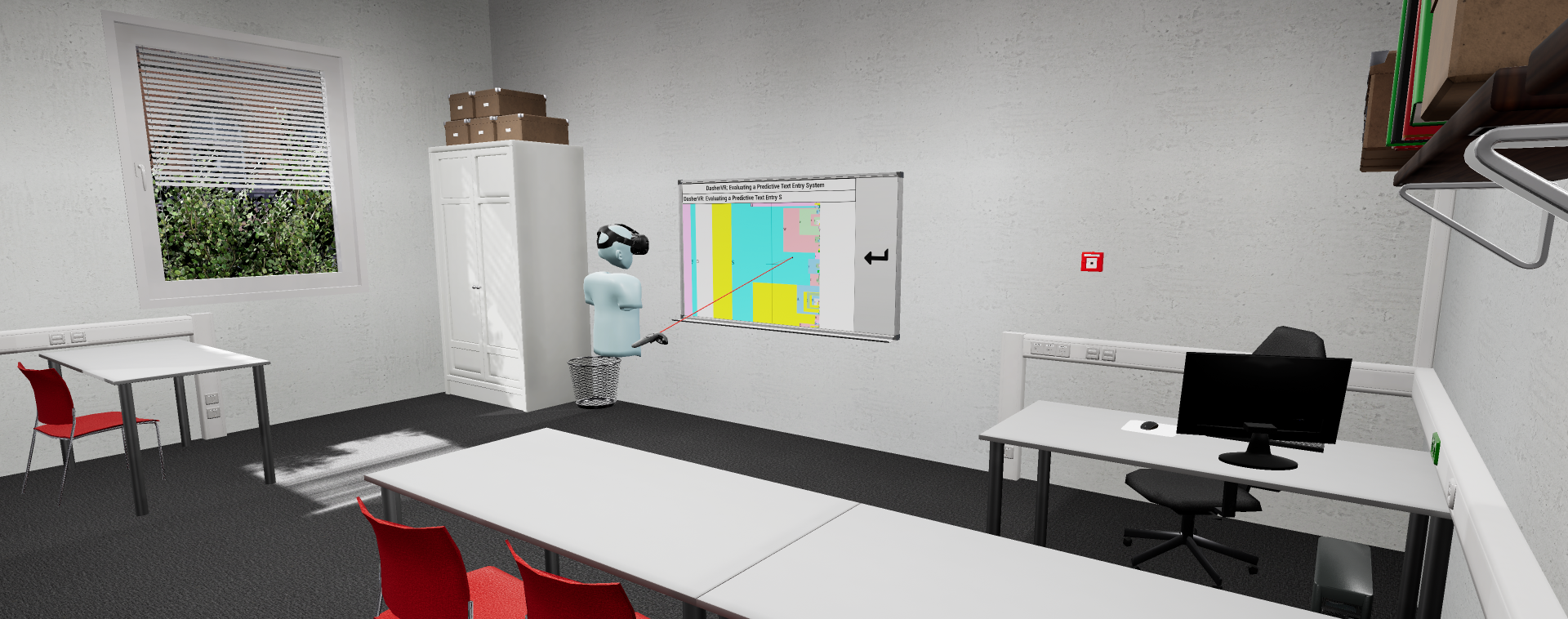
Inputting text fluently in virtual reality is a topic still under active research, since many previously presented solutions have drawbacks in either speed, error rate, privacy or accessibility. To address these drawbacks, in this paper we adapted the predictive text entry system "Dasher" into an immersive virtual environment. Our evaluation with 20 participants shows that Dasher offers a good user experience with input speeds similar to other virtual text input techniques in the literature while maintaining low error rates. In combination with positive user feedback, we therefore believe that DasherVR is a promising basis for further research on accessible text input in immersive virtual reality.
» Show BibTeX
@inproceedings{pape2023,
title = {{{DasherVR}}: {{Evaluating}} a {{Predictive Text Entry System}} in {{Immersive Virtual Reality}}},
booktitle = {Towards an {{Inclusive}} and {{Accessible Metaverse}} at {{CHI}}'23},
author = {Pape, Sebastian and Ackermann, Jan Jakub and Weissker, Tim and Kuhlen, Torsten W},
doi = {https://doi.org/10.18154/RWTH-2023-05093},
year = {2023}
}
Enhanced Auditoriums for Attending Talks in Social Virtual Reality
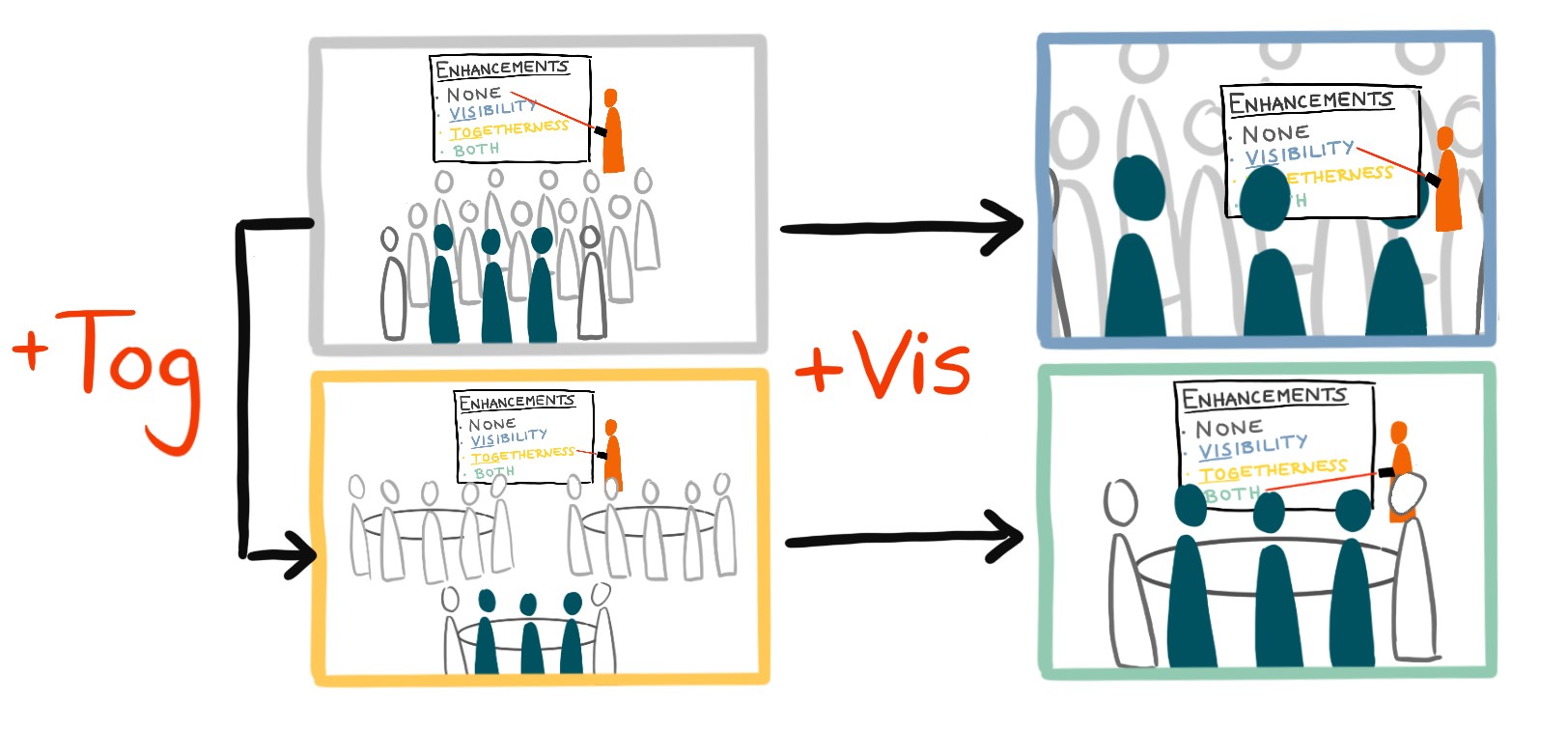
Replicating traditional auditorium layouts for attending talks in social virtual reality often results in poor visibility of the presentation and a reduced feeling of being there together with others. Motivated by the use case of academic conferences, we therefore propose to display miniature representations of the stage close to the viewers for enhanced presentation visibility as well as group table arrangements for enhanced social co-watching. We conducted an initial user study with 12 participants in groups of three to evaluate the influence of these ideas on audience experience. Our results confirm the hypothesized positive effects of both enhancements and show that their combination was particularly appreciated by audience members. Our results therefore strongly encourage us to rethink conventional auditorium layouts in social virtual reality.
@inproceedings{10.1145/3544549.3585718,
author = {Weissker, Tim and Pieters, Leander and Kuhlen, Torsten},
title = {Enhanced Auditoriums for Attending Talks in Social Virtual Reality},
year = {2023},
isbn = {9781450394222},
publisher = {Association for Computing Machinery},
address = {New York, NY, USA},
url = {https://doi.org/10.1145/3544549.3585718},
doi = {10.1145/3544549.3585718},
abstract = {Replicating traditional auditorium layouts for attending talks in social virtual reality often results in poor visibility of the presentation and a reduced feeling of being there together with others. Motivated by the use case of academic conferences, we therefore propose to display miniature representations of the stage close to the viewers for enhanced presentation visibility as well as group table arrangements for enhanced social co-watching. We conducted an initial user study with 12 participants in groups of three to evaluate the influence of these ideas on audience experience. Our results confirm the hypothesized positive effects of both enhancements and show that their combination was particularly appreciated by audience members. Our results therefore strongly encourage us to rethink conventional auditorium layouts in social virtual reality.},
booktitle = {Extended Abstracts of the 2023 CHI Conference on Human Factors in Computing Systems},
articleno = {101},
numpages = {7},
keywords = {Audience Experience, Head-Mounted Display, Multi-User, Social Interaction, Virtual Presentations, Virtual Reality},
location = {<conf-loc>, <city>Hamburg</city>, <country>Germany</country>, </conf-loc>},
series = {CHI EA '23}
}
Towards Discovering Meaningful Historical Relationships in Virtual Reality
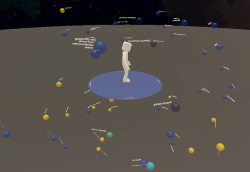
Traditional digital tools for exploring historical data mostly rely on conventional 2D visualizations, which often cannot reveal all relevant interrelationships between historical fragments. We are working on a novel interactive exploration tool for historical data in virtual reality, which arranges fragments in a 3D environment based on their temporal, spatial and categorical proximity to a reference fragment. In this poster, we report on an initial expert review of our approach, giving us valuable insights into the use cases and requirements that inform our further developments.
@INPROCEEDINGS{Derksen2023,
author={Derksen, Melanie and Weissker, Tim and Kuhlen, Torsten and Botsch, Mario},
booktitle={2023 IEEE Conference on Virtual Reality and 3D User Interfaces Abstracts and Workshops (VRW)},
title={Towards Discovering Meaningful Historical Relationships in Virtual Reality},
year={2023},
volume={},
number={},
pages={697-698},
doi={10.1109/VRW58643.2023.00191}}
Gaining the High Ground: Teleportation to Mid-Air Targets in Immersive Virtual Environments

Most prior teleportation techniques in virtual reality are bound to target positions in the vicinity of selectable scene objects. In this paper, we present three adaptations of the classic teleportation metaphor that enable the user to travel to mid-air targets as well. Inspired by related work on the combination of teleports with virtual rotations, our three techniques differ in the extent to which elevation changes are integrated into the conventional target selection process. Elevation can be specified either simultaneously, as a connected second step, or separately from horizontal movements. A user study with 30 participants indicated a trade-off between the simultaneous method leading to the highest accuracy and the two-step method inducing the lowest task load as well as receiving the highest usability ratings. The separate method was least suitable on its own but could serve as a complement to one of the other approaches. Based on these findings and previous research, we define initial design guidelines for mid-air navigation techniques.
@ARTICLE{10049698,
author={Weissker, Tim and Bimberg, Pauline and Gokhale, Aalok Shashidhar and Kuhlen, Torsten and Froehlich, Bernd},
journal={IEEE Transactions on Visualization and Computer Graphics},
title={Gaining the High Ground: Teleportation to Mid-Air Targets in Immersive Virtual Environments},
year={2023},
volume={29},
number={5},
pages={2467-2477},
keywords={Teleportation;Navigation;Avatars;Visualization;Task analysis;Floors;Virtual environments;Virtual Reality;3D User Interfaces;3D Navigation;Head-Mounted Display;Teleportation;Flying;Mid-Air Navigation},
doi={10.1109/TVCG.2023.3247114}}

